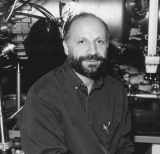|
||||||||||||||||||||||||||||||||||||||||

Mansour Shayegan
|
Mansour ShayeganProfessor of Electrical EngineeringPh.D. 1983, Massachusetts Institute of Technology
The research in my group is primarily on the physics of semiconductors, with an emphasis on their electronic properties. Our work involves the growth of GaAs/AlGaAs heterostructures by molecular beam epitaxy, and studies of ballistic and quantum transport in them. Of particular interest are the many-body phenomena observed in these low-dimensional structures at low temperatures and high magnetic fields. Our research includes both the fabrication, via molecular beam epitaxy followed by various lithography techniques, of very clean (low-disorder) quantum-confined carrier systems, and measurements of their electronic transport properties. The systems we are studying, namely, novel, high-quality quasi-two-dimensional electron and hole systems in selectively doped GaAs/AlGaAs heterojunction structures, are among the cleanest carrier systems available. In these structures, the mobile carriers are spatially separated from the dopant (impurity) atoms to minimize scattering. As a result, the mean-free-path of carriers at low temperatures reaches several microns, so that ballistic and phase-coherent transport can be studied. Such structures also provide a crucial and important test bed for new many-body physics, since the dominant interaction at low temperatures is the repulsion between the electrons themselves. In our work we study ballistic and phase-coherent transport, as well as many-body phenomena, in a variety of structures such as single- and multilayer electron and hole systems, wide parabolic quantum wells, superlattices, density-modulated systems, and quantum wires and dots. |
|||||||||||||||||||||||||||||||||||||||
|
|
|
| Contents copyright © 2002 Princeton University Department of Electrical Engineering All rights reserved. |
|